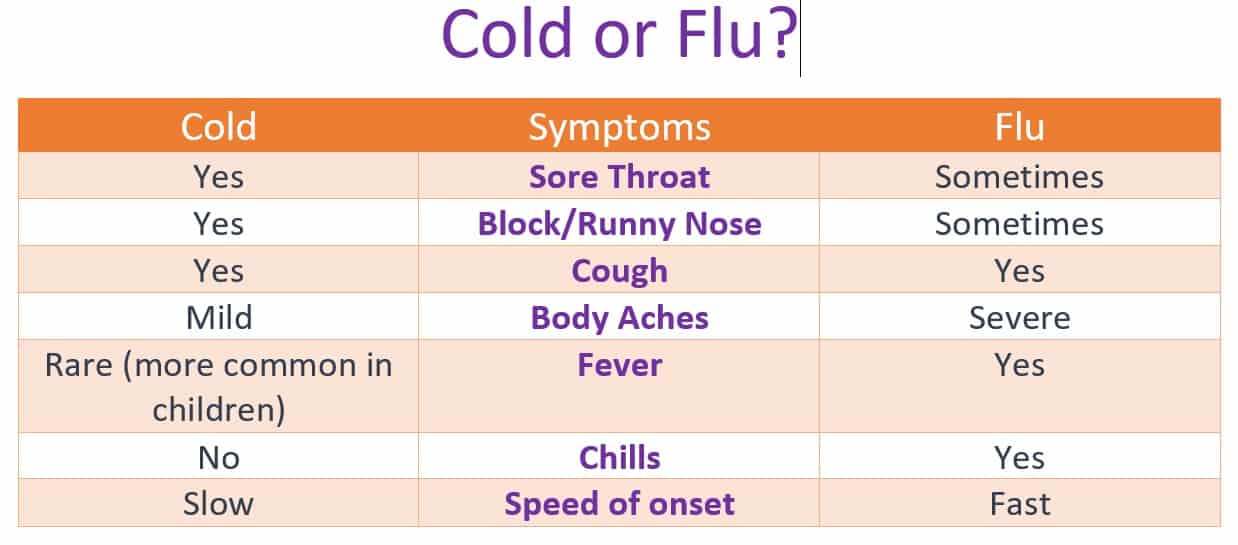Cold vs Flu – Know The Facts

Imagine yourself waking up one day sneezing, coughing, shivering, aching with a feeling in your throat like swallowing sand paper. How do you know if you have a cold or the flu? I do get asked this by patients and customers a lot during the winter season and I believe it’s important to know the difference between cold and flu symptoms. Some people think that a cold is less severe and is caused by bacteria, while others think that a flu is seasonal and cannot be prevented. Some even argue that the worst type of flu is the man flu!!  Above all, the rule of thumb is that a cold is generally milder than the flu. Whilst cold symptoms usually persist for a few days, flu symptoms can linger for longer and can make you feel ill for weeks. Surprisingly, a lot of people might not know that cold symptoms are also caused by viruses. Rhinovirus and adenovirus are usually the causes of the common cold. Influenza, commonly referred to as the flu is a viral infection caused by influenza virus. What are common cold symptoms and how long do they last? The common cold usually starts off with a sore throat which typically lasts for a couple of days. This is followed by nasal symptoms such as runny and blocked nose along with a tickly cough by day 5. Fever is not usually present in adults when suffering from a cold but a slight fever is possible. Fever is usually more common in children with a cold. Cold symptoms usually last for a week and the first 2 to 3 days is the most infectious stage, so it is advisable to avoid close contact with others. If cold symptoms last longer than a week, it can mean that you have a bacterial infection and hence a doctor’s visit is necessary. What are common flu symptoms? Flu is usually more severe than the common cold. Symptoms of flu typically consist of sore throat, congestion, cough, headache, fever and body aches. Swine flu in particular can cause symptoms such as diarrhea and vomiting. Flu symptoms usually gradually improve over a week but it is not uncommon that a flu can last for weeks. High risk populations such as elderly, people with long term conditions, asthmatic patients and young children are at greater risk of developing complications such pneumonia and bronchitis. Both the cold and influenza virus are airborne and can be easily transmitted into our body through the mucus membranes of the mouth, nose and eyes. Every time we touch any of these 3 areas with our hands, we could potentially infect ourselves with a virus. Hence, it is crucial that we wash our hands on a regular basis to prevent cold and flu symptoms.
Above all, the rule of thumb is that a cold is generally milder than the flu. Whilst cold symptoms usually persist for a few days, flu symptoms can linger for longer and can make you feel ill for weeks. Surprisingly, a lot of people might not know that cold symptoms are also caused by viruses. Rhinovirus and adenovirus are usually the causes of the common cold. Influenza, commonly referred to as the flu is a viral infection caused by influenza virus. What are common cold symptoms and how long do they last? The common cold usually starts off with a sore throat which typically lasts for a couple of days. This is followed by nasal symptoms such as runny and blocked nose along with a tickly cough by day 5. Fever is not usually present in adults when suffering from a cold but a slight fever is possible. Fever is usually more common in children with a cold. Cold symptoms usually last for a week and the first 2 to 3 days is the most infectious stage, so it is advisable to avoid close contact with others. If cold symptoms last longer than a week, it can mean that you have a bacterial infection and hence a doctor’s visit is necessary. What are common flu symptoms? Flu is usually more severe than the common cold. Symptoms of flu typically consist of sore throat, congestion, cough, headache, fever and body aches. Swine flu in particular can cause symptoms such as diarrhea and vomiting. Flu symptoms usually gradually improve over a week but it is not uncommon that a flu can last for weeks. High risk populations such as elderly, people with long term conditions, asthmatic patients and young children are at greater risk of developing complications such pneumonia and bronchitis. Both the cold and influenza virus are airborne and can be easily transmitted into our body through the mucus membranes of the mouth, nose and eyes. Every time we touch any of these 3 areas with our hands, we could potentially infect ourselves with a virus. Hence, it is crucial that we wash our hands on a regular basis to prevent cold and flu symptoms.


















